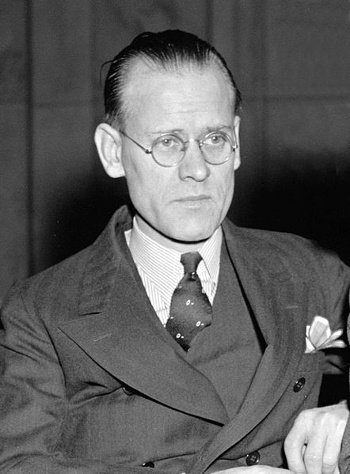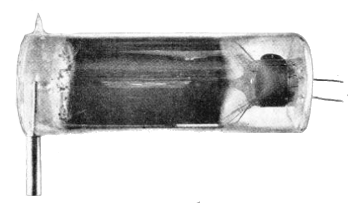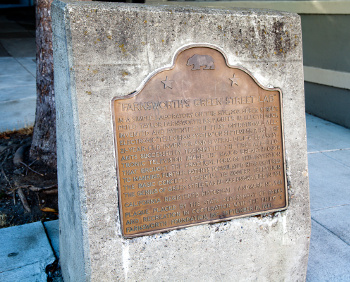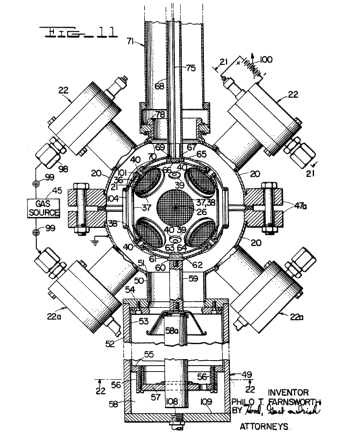Philo Farnsworth
August 20, 2015
My
parents bought their first
television set, capable of
receiving only
monochrome images, in 1950. It was housed in a huge, simulated
cherry wood cabinet about half as large as a
coffin, and it had doors to hide the picture tube, thus reinforcing the coffin effect. At that time, only one
station could be received,
WKTV, channel 13. Because of an
FCC channel reorganization, WKTV moved to channel 2 in 1959.
This was quite a change, since channel 13 occupied the
frequency range of 210-216
MHz, while channel 2 occupied the frequency range of 54-60 MHz. Fortunately, the
transmitter was very near to our house, since the
vacuum tube television receiver had limited
sensitivity. Only after installation of a large
attic antenna years later was it capable of faintly receiving one or two stations from
Syracuse, New York, just fifty
miles away.
While in
high school, I built a
Heathkit color television, a Model GR-295 with about twenty vacuum tubes, so I expanded my knowledge of
electronics and learned a few things about television. In my
college years, I worked one
summer at
WRGB, a
Schenectady, New York, television station, after passing an
operator license exam administered by the FCC. Such adventures in television
technology would have been delayed beyond
my generation without the work of
American inventor,
Philo Farnsworth, who was born on August 19, 1906.[1-4]

Philo T. Farnsworth (1906-1971)
Like Vannevar Bush, a prominent 20th century engineer born sixteen years earlier, Farnsworth became interested in mechanics and electronics at an early age.
I wrote about Vannevar Bush in an earlier article (Basic Research, October 22, 2010)
(Farnsworth in 1939, via Wikimedia Commons.)
Since there were more types of
mechanical devices than
electronic devices available to
engineers in the early part of the
20th century, early television systems had a mix of mechanical and electronic components. Images were scanned and
displayed using
spinning disks. Farnsworth's main contribution to television technology was the elimination of mechanical components to create the first all-electronic television system. The crucial part of the system was a
video camera tube that he called the "
image dissector."

Farnsworth's image dissector tube, as shown in the article, "Scanning with an electric pencil," Television News, vol. 1, no. 1 (March-April 1931), p. 51.
(Via Wikimedia Commons.)
As I wrote in an
earlier article (Teen Scientists, February 1, 2013), many successful
scientists and engineers show an interest in technology at a young age. Farnsworth, the eldest of five
children, was born to
Mormon parents on a
farm near
Beaver, Utah. When he was nearly a
teenager, his
family moved to another farm that had an
electrical generator, and Farnsworth became adept at its
maintenance.
He also found a pile of technology
magazines in his new home, and he enjoyed inventing electrical gadgets, including a
magnetic automobile lock for which he won a
cash prize in a magazine
contest.[1] In high school, he was an excellent
student of
physics and
chemistry, and it was there that he first outlined his idea for an electronic television system to one of his
teachers. After high school, he received a
correspondence school certificate in
radio technology from the
National Radio Institute.
Farnsworth attended
Brigham Young University, but he applied to the
United States Naval Academy, where he was admitted with high scores on an
entrance exam. When he found, however, that the
government would own rights to any
patents he might obtain while in
military service, he almost immediately applied for, and obtained, an
honorable discharge; the reason being that he was the eldest son of a fatherless family that needed his support, and he returned to Brigham Young University.
Farnsworth's future
brother-in-law, Cliff Gardner, also had an interest in electronics, so the pair started a radio repair shop in
Salt Lake City. The business failed, but Farnsworth remained in Salt Lake City, where he was introduced to two
San Francisco philanthropists who agreed to fund his television
research. Farnsworth
married Pem Gardner before the move to the location of his
California laboratory.
One of the first things that Farnsworth did after the move was to apply for patents on his television ideas. These were the first of Farnsworth's 165 lifetime patents, most of which are in television and radio technology. Farnsworth's image dissector camera tube transmitted its first image, a single
straight line, to a receiver in another room of his laboratory at 202 Green Street in San Francisco, thereby demonstrating an all-electronic television system. The image dissector used the
photoelectron emission of
cesium as its operating principle.

Monument placed at the site of Farnsworth's Green Street Laboratory (California Historical Landmark 941).
(Photo by Matthew Roth, via Wikimedia Commons. Click for larger image)
Farnsworth's image dissector video camera was extremely
inefficient. The straight line was formed by illuminating a
glass slide with the
intense light of an
arc lamp. Eventually, the
sensitivity was increased to the point that Farnsworth could image his
wife, who needed to keep her
eyes closed since intense lighting was still required. Farnsworth gave a public demonstration of his television system on August 25, 1934, at the
Franklin Institute in
Philadelphia.
While Philo's
fictional Futurama descendant,
Professor Hubert J. Farnsworth has a rival in
Dr. Ogden Wernstrom, Philo Farnsworth had as his
rival,
Vladimir Zworykin. Zworykin, who began television research at
Westinghouse, eventually became the head of
RCA's television
research and development.
Zworykin investigated the image dissector concept, but abandoned it because of its low sensitivity. RCA went on to develop its own camera tube, the
Iconoscope. As recalled by Zworykin in a 1970
interview, Farnsworth's problem was that he was too devoted to his dissector idea to investigate other approaches.[5-6] This is a cautionary tale for other inventors.
Farnsworth refused an offer from RCA to acquire his patents and to have him join their television team. This decision led to numerous
patent disputes between Farnsworth and RCA. After a short
employment at
Philco and the failed development of a
European television project, Farnsworth established the Farnsworth Television and Radio Corporation in 1938 in
Fort Wayne, Indiana, and acted as its director of research. In 1939, after much
legal wrangling, RCA
licensed Farnsworth's fundamental television patent[7] for a million dollars.
Farnsworth's company persisted through 1951, when it was acquired by
International Telephone and Telegraph (ITT), and Farnsworth became an ITT employee. At ITT, Farnsworth worked on a number of non-television inventions, including
radar systems; but, he was later fixated on
fusion energy with a device called a
Farnsworth–Hirsch fusor.
The fusion research did not go well at ITT, and it was terminated. Farnsworth continued his fusion research at Brigham Young University in 1967, but that venture closed in 1970, and it was a
financial disaster for Farnsworth. A
depressed and defeated Farnsworth died on March 11, 1971.

Fig. 11 of U.S. Patent No. 3,386,883, "Method and apparatus for producing nuclear fusion reactions," by Philo T. Farnsworth, June 4, 1968, and assigned to ITT.
(Via Google Patents.)
One notable, and the only
extant, appearance of Farnsworth on
broadcast television was in 1957 on the
game show, "
I've Got A Secret."[8] Unlike the publicly recognized technology
superstars of today, such as
Steve Jobs and
Bill Gates, Farnsworth was not identified on the
medium he helped to create.
![]()
References:
- As usual, Wikipedia has a very thorough article about Farnsworth.
- Mary Bellis, "Philo Farnsworth, Father of the Television," Inventors Web Site at About.com.
- Philo T. Farnsworth Biography, Engineering and Technology History Wiki.
- George Everson, The story of television, the life of Philo T. Farnsworth," W.W. Norton (New York, 1949), pp. 288.
- Frank Lovece, "Zworykin v. Farnsworth Part I: The Strange Story of TV's Troubled Origin," Video magazine, August, 1985.
- Frank Lovece, "Zworykin v. Farnsworth Part II: TV's Founding Fathers Finally Meet -- in the Lab," Video magazine, September, 1985.
- Philo T. Farnsworth, "Television system," U.S. Patent No. 1,773,980, August 26, 1930.
- Philo Farnsworth on I've Got A Secret, YouTube Video.
Permanent Link to this article
Linked Keywords: Parent; television set; receiver; black-and-white; monochrome; prunus; cherry wood; coffin; television station; WKTV; Federal Communications Commission; FCC; frequency; MHz; transmitter; vacuum tube; sensitivity; attic; antenna; Syracuse, New York; mile; high school; Heathkit; color television; electronics; undergraduate education; college years; summer; WRGB; Schenectady, New York; General radiotelephone operator license; operator license exam; technology; baby boomer; my generation; American; inventor; Philo T. Farnsworth (1906-1971); Vannevar Bush; 20th century; engineer; mechanics; electronics; Wikimedia Commons; machine; mechanical device; electronic device; display device; displayed; rotation; spinning; video camera tube; image dissector tube; scientist; child; children; Mormonism; Mormon; agriculture; farm; Beaver, Utah; adolescence; teenager; family; electrical generator; maintenance and repair; magazine; magnetic; automobile; lock; cash; prize; competition; contest; student; physics; chemistry; teacher; distance education; correspondence school; academic certificate; radio; National Radio Institute; Brigham Young University; United States Naval Academy; entrance examination; government; patent; military service; honorable discharge; brother-in-law; Salt Lake City; San Francisco; philanthropy; philanthropist; research; marriage; married; California; laboratory; straight line; photoelectric effect; photoelectron emission; cesium; Monument; Matthew Roth; energy conversion efficiency; inefficient; microscope slide; glass slide; intensity; intense; light; arc lamp; wife; eye; Franklin Institute; Philadelphia; fiction; fictional; Futurama; descendant; Professor Hubert J. Farnsworth; Dr. Ogden Wernstrom; rival; Vladimir Zworykin; Westinghouse; RCA; research and development; Iconoscope; interview; patent infringement; patent dispute; employment; Philco; Europe; European; Fort Wayne, Indiana; legal; intellectual property; license; International Telephone and Telegraph (ITT); radar system; fusion power; fusion energy; Farnsworth–Hirsch fusor; finance; financial; crisis; disaster; depression; Google Patents; extant; broadcast television; game show; I've Got A Secret; superstar; Steve Jobs; Bill Gates; media; medium; Philo T. Farnsworth, "Television system," U.S. Patent No. 1,773,980, August 26, 1930.